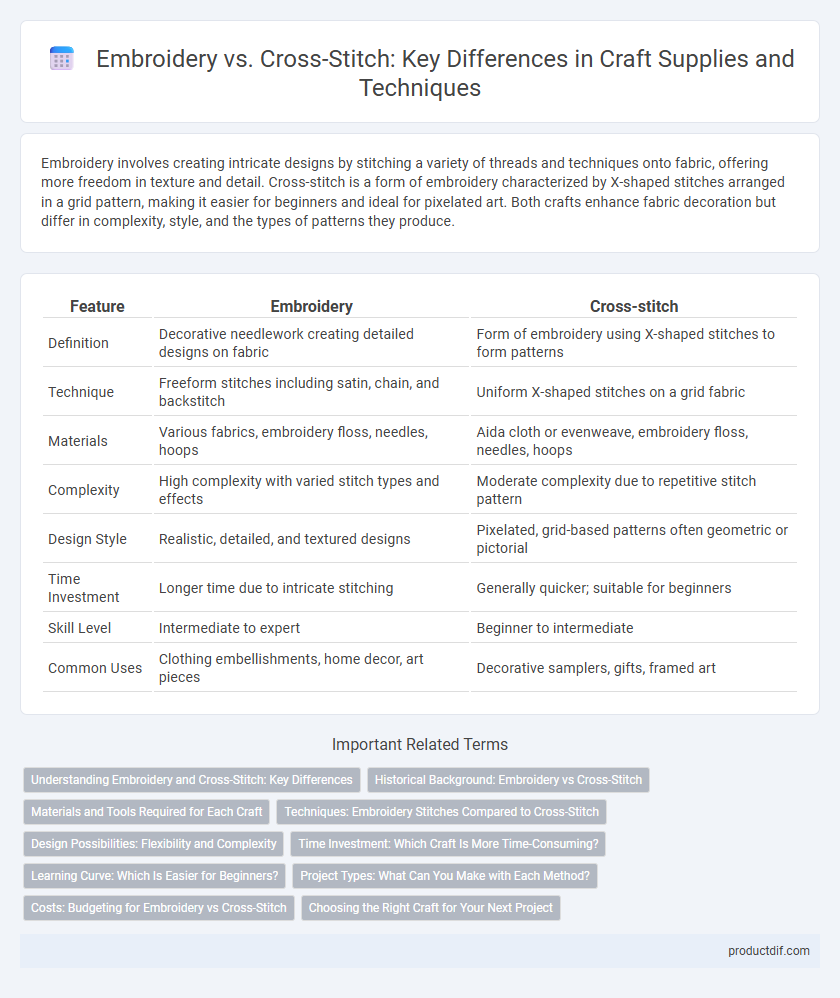Embroidery involves creating intricate designs by stitching a variety of threads and techniques onto fabric, offering more freedom in texture and detail. Cross-stitch is a form of embroidery characterized by X-shaped stitches arranged in a grid pattern, making it easier for beginners and ideal for pixelated art. Both crafts enhance fabric decoration but differ in complexity, style, and the types of patterns they produce.
Table of Comparison
| Feature | Embroidery | Cross-stitch |
|---|---|---|
| Definition | Decorative needlework creating detailed designs on fabric | Form of embroidery using X-shaped stitches to form patterns |
| Technique | Freeform stitches including satin, chain, and backstitch | Uniform X-shaped stitches on a grid fabric |
| Materials | Various fabrics, embroidery floss, needles, hoops | Aida cloth or evenweave, embroidery floss, needles, hoops |
| Complexity | High complexity with varied stitch types and effects | Moderate complexity due to repetitive stitch pattern |
| Design Style | Realistic, detailed, and textured designs | Pixelated, grid-based patterns often geometric or pictorial |
| Time Investment | Longer time due to intricate stitching | Generally quicker; suitable for beginners |
| Skill Level | Intermediate to expert | Beginner to intermediate |
| Common Uses | Clothing embellishments, home decor, art pieces | Decorative samplers, gifts, framed art |
Understanding Embroidery and Cross-Stitch: Key Differences
Embroidery and cross-stitch are both popular needlework techniques used in craft supply projects, but they differ significantly in style and method. Embroidery typically involves various stitches like satin, chain, and backstitch applied freely on fabric to create intricate designs, while cross-stitch uses X-shaped stitches arranged in a grid pattern on evenweave fabric for pixelated images. Understanding these distinct approaches helps crafters choose the right technique based on desired texture, detail, and project complexity.
Historical Background: Embroidery vs Cross-Stitch
Embroidery, with origins tracing back to ancient Egypt and China, represents one of the oldest textile arts used for decorating fabric with needle and thread. Cross-stitch, a specific form of counted-thread embroidery, emerged prominently in medieval Europe as a practical and decorative technique for household linens and samplers. Both crafts reveal rich cultural histories but differ in stitch technique and traditional applications, with embroidery encompassing diverse styles and cross-stitch characterized by its distinctive X-shaped stitches.
Materials and Tools Required for Each Craft
Embroidery requires a variety of threads such as cotton, silk, or metallic floss, along with needles of different sizes, embroidery hoops, and fabric like linen or cotton. Cross-stitch primarily uses Aida or evenweave fabric, embroidery floss, blunt tapestry needles, and a hoop or frame to maintain tension. Both crafts benefit from scissors, but variations in fabric type and needle choice distinctly influence the technique and final texture of the stitched design.
Techniques: Embroidery Stitches Compared to Cross-Stitch
Embroidery encompasses a wide variety of stitches such as satin, chain, and French knots, allowing for intricate textures and detailed designs on fabric. Cross-stitch relies on X-shaped stitches forming uniform pixel-like patterns, making it ideal for creating precise images and geometric shapes. Techniques in embroidery provide greater versatility in stitch forms, while cross-stitch emphasizes consistency and simplicity in each stitch to build complex motifs.
Design Possibilities: Flexibility and Complexity
Embroidery offers extensive design flexibility, allowing for a variety of stitches, textures, and intricate detailing that can create highly complex patterns. Cross-stitch uses a grid-based pattern with X-shaped stitches, making it simpler but ideal for creating pixelated, geometric designs. The choice between embroidery and cross-stitch depends on whether the project prioritizes detailed texture or structured, uniform motifs.
Time Investment: Which Craft Is More Time-Consuming?
Embroidery typically demands more time investment due to its detailed techniques and varied stitch patterns, requiring greater precision and skill compared to cross-stitch. Cross-stitch uses a grid-based pattern with uniform X-shaped stitches, making it faster and more straightforward for beginners. Craft enthusiasts seeking quicker project completion often prefer cross-stitch, while those prioritizing intricate designs choose embroidery despite the longer time commitment.
Learning Curve: Which Is Easier for Beginners?
Cross-stitch features a straightforward grid pattern with X-shaped stitches making it easier for beginners to learn and follow, while embroidery offers a wider range of stitches requiring more skill and practice to master. Cross-stitch patterns often use counted threads on evenweave or Aida fabric, simplifying counting and stitch placement for novices. Embroidery demands understanding of various techniques and textiles, resulting in a steeper learning curve compared to cross-stitch.
Project Types: What Can You Make with Each Method?
Embroidery allows for intricate designs on fabrics, making it ideal for customizing clothing, home decor, and accessories with detailed patterns or monograms. Cross-stitch excels in creating pixelated images and geometric patterns, perfect for samplers, wall hangings, and gifts featuring alphabets or motifs. Both techniques enable unique, handcrafted projects but differ in style versatility and design complexity.
Costs: Budgeting for Embroidery vs Cross-Stitch
Embroidery typically requires fewer materials such as specialized threads and backing fabrics, making it more cost-effective for beginners on a budget. Cross-stitch demands an evenweave fabric like Aida cloth, pre-printed patterns, and multiple floss colors, which can increase initial expenses. Both crafts offer scalable costs depending on complexity, but cross-stitch patterns and kits tend to be more accessible and affordable for beginners.
Choosing the Right Craft for Your Next Project
Embroidery offers versatile stitching techniques and intricate designs, making it ideal for projects requiring detailed personalization and texture. Cross-stitch features a grid-based pattern using X-shaped stitches, perfect for beginners or those seeking a more structured and pixelated design style. Selecting between embroidery and cross-stitch depends on your desired level of complexity, skill, and the aesthetic outcome of your craft project.
Embroidery vs Cross-stitch Infographic

 productdif.com
productdif.com